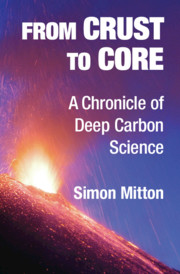Book contents
- From Crust to Core
- From Crust to Core
- Copyright page
- Dedication
- Contents
- Foreword
- Acknowledgments
- Introduction
- 1 Why Carbon in Earth Matters
- 2 The Origin of Deep Carbon in Deep Space
- 3 Deliveries of Cosmic Carbon Continue
- 4 On the Nature of Earth’s Interior
- 5 Earth’s Physical Interior Revealed
- 6 Thousands, Millions or Billions
- 7 Physics and Chemistry of Deep Earth
- 8 Confronting the Continental Drift Conundrum
- 9 The Mid-Atlantic Ridge and Rift Valley
- 10 Earth’s Deep Dynamics Discovered
- 11 Reversals of Fortune
- 12 Deep Carbon
- 13 Carbon-Bearing Phases in the Mantle
- 14 Diamond in the Mantle
- 15 Deep Life
- Glossary
- Biographical Notes
- Index
- References
13 - Carbon-Bearing Phases in the Mantle
Published online by Cambridge University Press: 19 December 2020
- From Crust to Core
- From Crust to Core
- Copyright page
- Dedication
- Contents
- Foreword
- Acknowledgments
- Introduction
- 1 Why Carbon in Earth Matters
- 2 The Origin of Deep Carbon in Deep Space
- 3 Deliveries of Cosmic Carbon Continue
- 4 On the Nature of Earth’s Interior
- 5 Earth’s Physical Interior Revealed
- 6 Thousands, Millions or Billions
- 7 Physics and Chemistry of Deep Earth
- 8 Confronting the Continental Drift Conundrum
- 9 The Mid-Atlantic Ridge and Rift Valley
- 10 Earth’s Deep Dynamics Discovered
- 11 Reversals of Fortune
- 12 Deep Carbon
- 13 Carbon-Bearing Phases in the Mantle
- 14 Diamond in the Mantle
- 15 Deep Life
- Glossary
- Biographical Notes
- Index
- References
Summary
Earth is the only known habitable planet in the solar system. Although there are half a dozen planetary moons that may have habitable zones beneath their surfaces, astronomers have yet to find an exoplanet with conditions deemed suitable for life on its surface. From a geological point of view, Earth’s distinctive features include the presence of life, the abundance of liquid water, the long-term tectonic system and the profusion of organic carbon in contact with the oxygen-bearing atmosphere. The carbon cycle inextricably binds biological life at the surface with carbon on the move in the interior. Through laboratory experiments, we have discovered that, following subduction, carbon-bearing materials undergo great transformation in the high-pressure hothouse of the mantle. Earth’s subduction factory plays a key role in the deep carbon cycle by feeding the mantle with different carbon phases, four-fifths of which are carbonates and one-fifth organic carbon, proportions that have remained relatively stable since Earth’s biosphere became established.
- Type
- Chapter
- Information
- From Crust to CoreA Chronicle of Deep Carbon Science, pp. 261 - 281Publisher: Cambridge University PressPrint publication year: 2020

